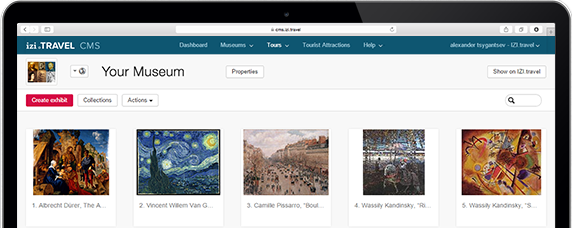Audioguía Sala Rio
- Descarga la aplicación
- iOS
- Android
- Windows Phone
We are entering Sala Rio that has 13 works.
As we walk into this space, let us take a pause. lets calm down, listen to our breathing.
Here you will see the works of five artists who hail from different parts of the world - Bangkok, Australia, Portugal, Canada, Syria and a Syrian artist from Belgium.
You see right upfront the Wooden Door. It celebrates the mastery of Fatimid woodworkers. Here the artist Naeem Mawji (from Canada) has used modern technologies to invoke this part of our heritage.
And here is another door, a work in mixed media titled, Door of Knowledge by Heena Gilani (from Bangkok). It also invokes the Fatimid period and draws inspiration where pursuit of knowledge in all forms was valorised.
Ismael Ali de Unzaga from Portugal work also uses this motif of door, look into the background behind the monks, that is painted celosia flowers. The door opens up to a spiritual journey!
Rayhan Madhani from Australia, in his painting invites contemplation and reflection highlighting the temporal nature of our presence, which marks the continuity of across our past, future and present.
Evoking and rightfully bringing to forward the salient and cardinal aspects of our heritage, this beautiful wood sculpture by Awos Ward from Belgium. A Syrian artist who uses this powerful Azobe wood, much like the characteristics of wood, the work highlights preservation and continued sense of heritage and identity. But most importantly, if you look at the face, it symbolizes an individual’s struggle to find peace and sustain an ethical practice in face of adversity.
All this is well summed up in this two piece Marble Sculpture by Ali Fakhour from Salamieh, Syria. In the first part of this sculpture we see the Imamat in form of fist grasping this universe if the universe progresses without the Imamat it will take people to chaos. The globular shape inside the fist stands for the universe which knowledge is possessed by the Imamat. In the second piece you see Imamat as the mind which gives us generously and stretches it's rope so we can cling to it in order to reach salvation.
Truth and Beauty always go together. That is why art becomes important vehicle to articulate the aesthetics for a community.
Now, we are in Room A-37: In this space we will see how Art engages with the real world.
Refugees and displacement has become a defining issue of the 21st century that features mobility, uncertainty and fragility.
Here this sculpture by Gulzar Quintino of Portugal reflects on this refugee crisis. Incidentally, she had to migrate to Portugal from Mozambique in 1974 to escape civil unrest.
Artists have always offered some of the more powerful acts of solidarity responding to the crisis of the world and here we see Gulzar’s share her responsibility as a citizen of the world.
These photographs are the work of a self-taught photographer Yamam Alshaar from Syria.
They remind us of the details the ravages, losses and despair wrought by War, as families are broken apart and left bereft.
These photographs are anchoring our memory of what that condition is at home which one must leave to distant lands to survive.
To the plight in Yaman’s work, Gulzar offers the transitory moment of hope.
Take a moment to absorb these powerful thoughts behind these works.
Lets move across to another part of Sala Rio.
You are now in Room A-8:
Here we will see four interesting works each drawn from different regions of the world and different mediums; these artists are reminding us about Family.
Rosmina’s sculpture through use of dolls made of found/recycled materials talks about the idea of the diverse family
Lara Pedro’s Canvas draws our attention to the centrality of Women - in our families and lives. As the title of the painting says it all: Genesis.
This is a delicate piece of art by Mohammadali Ataollahimoghadam from Iran draws from the Madhubani style of painting that celebrated and evoked the quotidian nature of life of the royalty as well as people.
Boris Maramatshoev from Dushanbe, Tajikistan offers this powerful sentiment of having a strong and loving family.
It beautifully captures as to how art plays an important role in creating such pathways nurturing one’s family and one’s spiritual journey.
We are now in Room A-9:
This is called an Installation.
This is a delicate work that uses textile as a material and plays with light and shadows to create a spiritual intervention in a secular space.
If you notice carefully it has incorporated the intricacies of the marble lattice work of the famous Mughal architecture that allows at once to be visible and invisible.
Your movement around the work will reveal different elements.
Art always has played an important role in creating significant space that enables contemplation: Truth and Beauty.
This marks the end of Zone 1 of the exhibition: We saw 13 works. Please do not forget to make a note for yourself about the works and your experience in Sala Rio.
How did you feel?
What moved you?
What did you learn?
What did you think of the display of art?
Now we are moving on into Sala Lago (Area 2)
Paradas del tour
-
The Return; Awos Ward, Sculpture, France
-
The Throne; Ali Fakhour, Sculpture, Syria
-
Majesty; Mohammadali Ataollahimoghadam, Paper Media, Iran
-
Wat Mangkon Kamalawat; Ismael Ali De Unzaga, Mixed Media, Portugal
-
Family; Boris Maramatshoev, Canvas Media, Tajikistan
-
Refugees; Gulzar Quintino, Sculpture, Portugal
-
Fatimid Wood Carving; Naeem Anil Mawji, Sculpture, Canada
-
Time is all at Once; Rayhaan Madhani, Canvas Media, Australia N/Z
-
Door of Knowledge; Heena Gilani, Mixed Media, Far East
-
My Khandan; Rosmina Gokrani, Sculpture, Kenya
-
Full of Life; Yamam Alshaar, Photography, Portugal
-
Masungulu; Lara Pedro, Canvas Media, Portugal
Reseñas
Descargue la app gratuita de izi.TRAVEL
¡Cree sus propias audioguías!
La utilización del sistema y la app de guía para móvil es gratuita


